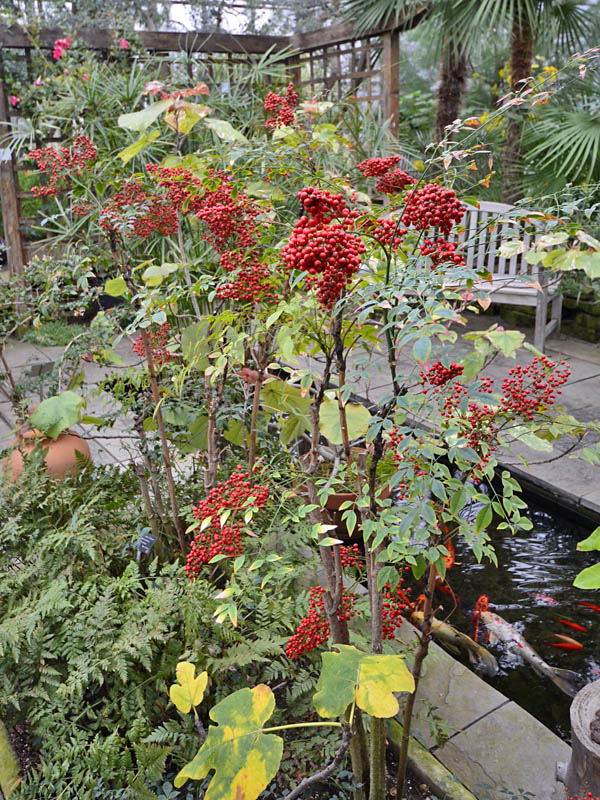| General Description | Sacred Bamboo is an evergreen shrub with multiple stems covered with glossy bi- to tri-pinnately compound leaves which change colour from green in summer to bright red in winter; foliage is accompanied by red berries.
|
| ID Characteristic | Pinnately compound leaves with two or three leaflets, on thin medium to fine textured stems with yellow wood characteristic of the Berberidaceae family. In winter, the leaves are bright red.
|
| Shape | Upright weeping shrub.
|
| Landscape | Sacred Bamboo has a wide variety of landscape uses, from foundations to hedges. Uniformity can be hard to achieve in plants grown from seed and can result in a mixed texture when planted 'en masse'.
|
| Propagation | Sow seeds as soon as possible as they have very poor germination rates. The seed can be germinated by cold stratification or with cold, moist pre-chilling. Division is more common when reproducing a unique specimen for further development and can be accomplished by cutting the root ball in spring. Cuttings can be taken from semi-hardwood or hardwood, between 10-15 cm and rooted in a well-drained media.
|
| Cultivation | It grows well in moist, well-drained, rich loamy soils. Best growth occurs in full sun and is drought tolerant however, can tolerate shade in hotter regions. |
| Pests | No notable pests, but may be susceptible to Nandina Mosaic which causes mottled colouring on the leaves.
|
| Notable Specimens | Queens Botanical Garden, Flushing, New York, United States of America.
|
| Habitat | Sacred Bamboo grows in the moist woodlands, ravines and valleys in the mountains and warmer regions of Eastern Asia and Japan.
|
| Bark/Stem Description | The bark is reddish in colour when young and matures to a light brown, its texture is medium to fine.
|
| Flower/Leaf Bud Description | The buds are pinkish, 1 - 2 mm and nondescript. They are hidden by the ensheathing base of the petiole and are only visible after removing the leaf.
|
| Leaf Description | Sacred Bamboo has broadleaf, evergreen foliage, emerging as alternate bi- to tri-pinnately elliptic-lanceolate compound leaves, 30-90 cm long. Glabrous leaves emerge pinkish and bronzy red and turn a metallic bluish green, becoming hues of red in winter.
|
| Flower Description | The perfect white flowers are found on erect panicles 15 - 30 cm long in early summer, blooms are 5 - 10 mm and have between 3 - 6 petals.
|
| Fruit Description | The fruit of Sacred Bamboo is borne in panicles of bright red berries 6 - 8 mm across, persistent from autumn to winter; each berry contains 1 - 3 seeds.
|
| Colour Description | Sacred Bamboo foliage is metallic bluish-green changing to bright shades of red in autumn and winter. The bark is reddish and matures to a light brown colour. White flowers and small red berries.
|
| Texture Description | Texture can be fine if the plant is kept pruned, otherwise it is a medium textured plant.
|
